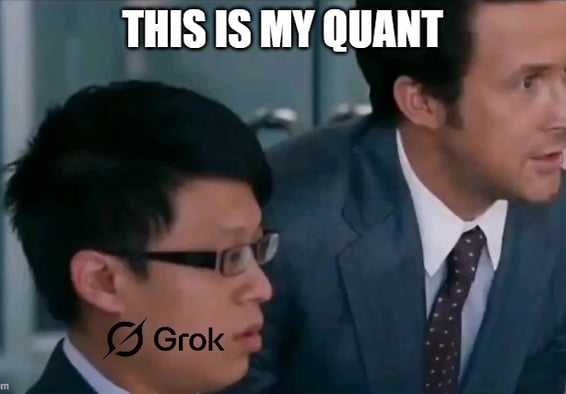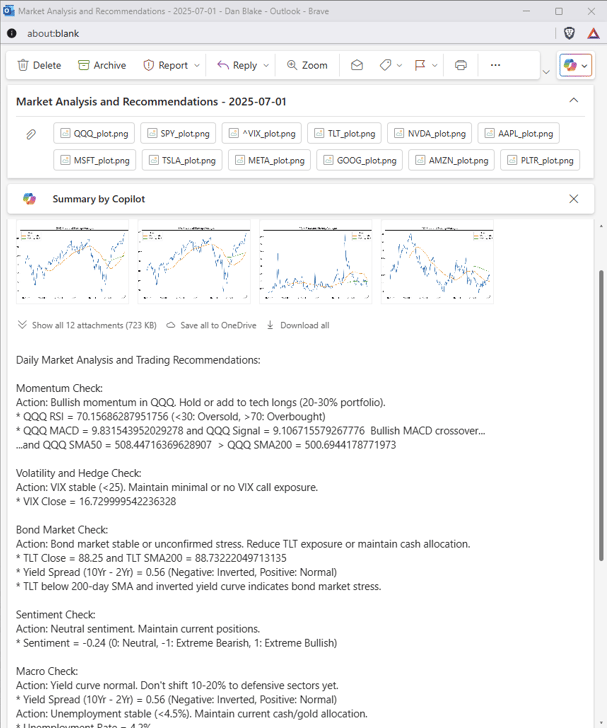Hey, Ken Griffin, this is my AI quant
Retail Investing in the AI Age
AIINVESTING
7/2/20254 min read


On June 16, 2025, Ken Griffin, founder of Citadel, a hedge fund and financial services company, published an article where he stated that “the likelihood of retail investors beating professional traders is extremely low.” Many critical responses followed pointing out, among other things, that “many retail investors feel that his approach fails to acknowledge the depth of knowledge they already possess, particularly concerning controversial practices like naked short selling and the functioning of dark pools.” (“Ken Griffin Now Says…”, Franknez.com).
Full disclosure: I am not a finance professional. I’m an IT Consultant focused on AI and business software. I’m not a day-trader and never will be since I could go to Las Vegas and get the same experience albeit in a system that is not as “rigged.” As a “buy and hold” investor I have pretty good instincts but my timing is always way off which is the same thing as being wrong. So, yes, I could not beat a good professional trader on my own and wouldn’t try.
However, give a retail investor the right AI tools and the playing field likely gets pretty even. Let’s face it, AI is coming for most of the knowledge worker jobs of today and many others albeit hopefully creating new jobs and advancing prosperity as all tech advancements have in history. The days when investors are willing to pay fees to have someone invest their money are probably numbered.
There are a plethora of AI tools on the market for investing that fall into several categories including:
- Robo-Advisors (Automated Portfolio Management)
- Stock and ETF Analysis Platforms
- Technical Analysis and Trading Tools
- Social and Copy Trading Platforms (Hilariously, the “Inverse Cramer” and “Pelosi Portfolio” are among the highest performing copy trades beating the S&P 500 and most other portfolios.)
- Financial Research and Data Analytics
- Trade Signal and Alert Services
- Personalized Investment Advisors
In addition to those feature-specific tools, a retail investor with only some basic prompt engineering skills could get valuable information by prompting an LLM or reasoning model to identify trends or help create an investment strategy. An investor with an AI skillset might even train an AI model with historical financial data and leverage that tool and AI agents to give them a unique edge in some type of macro or short-term trading scheme.
To test this out myself, I asked Grok to give me a strategy to invest in a market that was in clear bubble territory (possibly the Mother of All Bubbles, aka the “MOAB”). Grok produced an impressive strategy, evaluating past “end of cycle” periods, explaining how a great deal of gains are made in the final “melt-up” phase, suggesting momentum trades to target and identifying technical indicators to time entries/exits. The summary of the strategy is as follows:
Ride the 20% upside in tech with 20-30% in QQQ and select names, using trailing stops and technicals to exit. Hedge with 5-10% in SPY/QQQ puts, VIX calls, and TLT shorts. Keep 10-15% in gold/cash. As crash signals emerge (VIX spikes, yield curve inverts, retail euphoria peaks on X), shift to shorts (SQQQ, HYG puts) and defensives (XLV, XLP). Post-crash, buy quality stocks at troughs. Rebalance monthly, cap leverage at 10%, and monitor X, CBOE, and FRED for real-time signals. This balances the dot-com and 2008 lessons: ride the wave, but be ready to jump off with parachutes deployed.
Next, I prompted Grok to “write me python scripts that can monitor everything in the above strategy and advise on actions to take that I can run each morning and send me an email before market open. Grok happily obliged, generating two scripts: one for data collection and analysis, another for generating recommendations and sending emails. With a few minor modifications, these scripts ran successfully. After scheduling the scripts to run daily, monitoring results, and 6-8 hours of code tweaks to improve the code (with help from GitHub Copilot) I have an automatic email delivered to me before each trading day telling me how to invest. Here is a snippet of the email:


Will I be able to “beat the pros” with this tool and strategy? Maybe. Probably a lot of them. I had a “pro” financial advisor lose me money in my portfolio in the years 1997-1998 and paid fees for that result. If you remember that time period, you know how ridiculous that is. Around that same time, investors began to learn that zero mutual funds and few hedge funds ever beat the S&P 500 index, launching the era of the QQQ and S&P ETFs and making Larry Fink the most powerful person in the world (how did that happen when it’s not even his money that Blackrock is investing). How many pros avoided big losses in the Great Recession, aka Global Financial Crisis (GFC) in 2007-2008 other than the stars immortalized in the movie classic “The Big Short”? The other truth that became obvious to “retail investors” is that the pros that direct investments for their relatively small portfolios wouldn’t bother with them if they were fantastic traders who are able to consistently beat the market. These top pros would just invest their own money and maybe manage portfolios and private equity investments for high-net-worth individuals, which is what they actually do. Many of these top pros are also consistently wrong. So, retail investors have been smart to put their money in index funds and leave it there and the ones that have done this have outperformed almost every other strategy. AI tools can now give the retail investor better guidance based on the same market data, indicators, metrics, and historical trends that the best pros rely on.
The AI tools available to retail investors will continue to mature and get better to the point where a retail investor can regularly outperform the market. To Ken Griffin: This is my AI quant!
